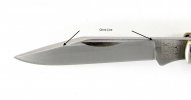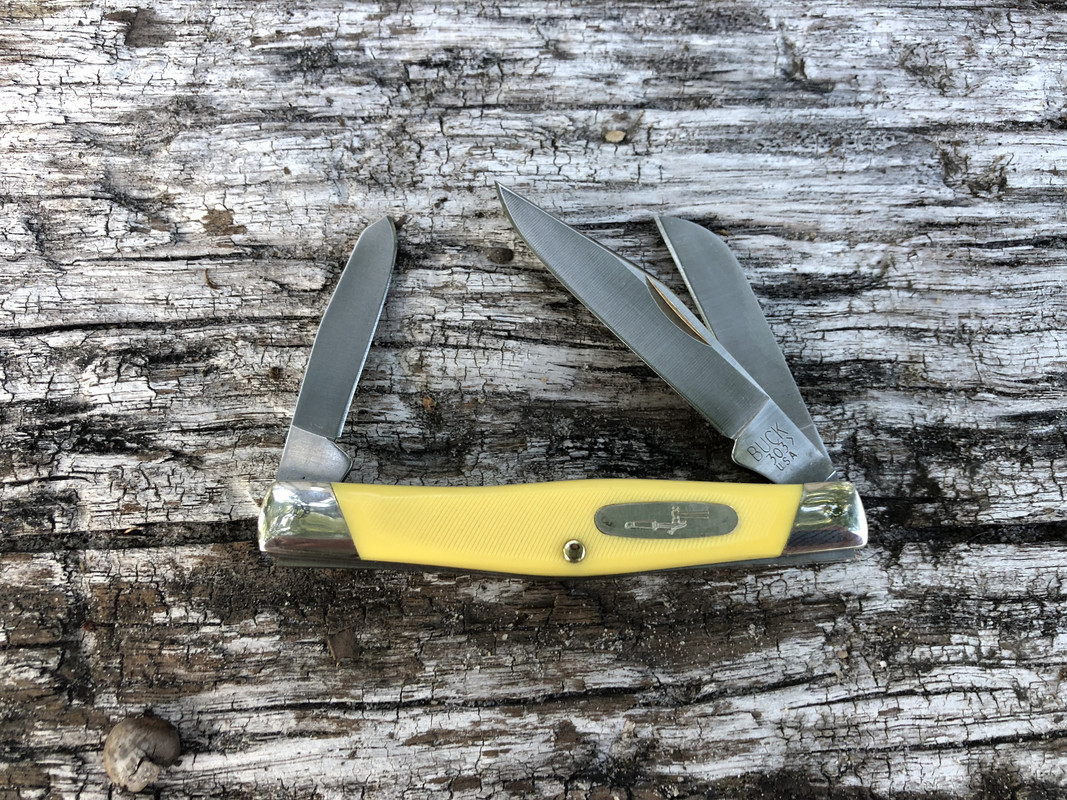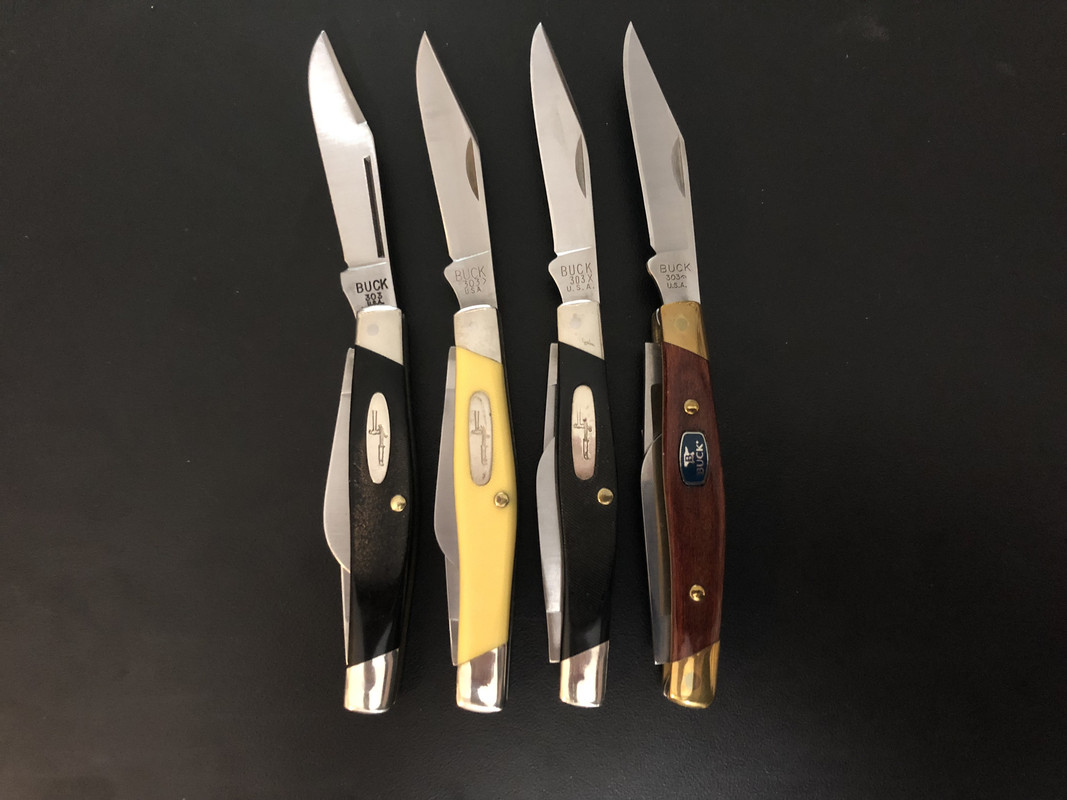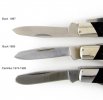I'm thinking about getting a 301 Stockman to replace my old Schrade which I gave away twenty years ago. However, have they always been hollow ground or is it a recent thing? My Schrade was full flat grind but I would like a US made knife and the new ones are not, and I'd rather get a Buck.
-
The BladeForums.com 2024 Traditional Knife is ready to order! See this thread for details: https://www.bladeforums.com/threads/bladeforums-2024-traditional-knife.2003187/
Price is$300$250 ea (shipped within CONUS). If you live outside the US, I will contact you after your order for extra shipping charges.
Order here: https://www.bladeforums.com/help/2024-traditional/ - Order as many as you like, we have plenty.
You are using an out of date browser. It may not display this or other websites correctly.
You should upgrade or use an alternative browser.
You should upgrade or use an alternative browser.
When did Buck stop using full flat grind on Cadet and 301 Stockman?
- Thread starter Hjalmar69
- Start date
afishhunter
Basic Member
- Joined
- Oct 21, 2014
- Messages
- 14,434
I believe Buck's 301 (and the other 300 series) went to hollow grind around 1986 (give or take) when they started to make them in-house, and no longer contracted Camillus to make them.
Oh, the Buck 37x and 38x knives are made offshore. The 30x knives are made in Idaho.
BTW All the Schrade and Camillus made Buck 300 series have a long pull on at least the main clip point blade.
(I don't know if the secondaries had nail nicks or long pulls. Perhaps someone who has one can chime in on that? )
)
Also those made by Schrade (not Camillus) have the cursed (innately weaker and defective) "Swendon Key" construction.
The Camillus made all have the normal pinned construction.
(The way I hear the tale, Buck switched from Schrade to Camillus because of the number of 301's sent in for repair because the Swendon Key failed in/during normal use.)
(Note: I am of the opinion that had Schrade dumped the Swendon Key construction, and that fool "guaranteed against loss" nonsense, they might still be going.
I'd be surprised if only as little as half the Schrade manufactured knives that left the factory were not free replacements for a failed Swendon Key, and/or an allegedly "lost" knife. (the "lost knife" replacements to include all the various Schrade brands.)
Taking "Human Nature" into account, how many of the knives sent out under that foolish "guaranteed against loss" guarantee were really for a lost knife? My guess is less than 0.5 percent.
That "guarantee against loss" unquestionably struck many/most as "buy one get one (or more) free".
The free knife to replace the "lost" one had the same "guaranteed against loss" as the original purchase, as far as I know.)
Oh, the Buck 37x and 38x knives are made offshore. The 30x knives are made in Idaho.
BTW All the Schrade and Camillus made Buck 300 series have a long pull on at least the main clip point blade.
(I don't know if the secondaries had nail nicks or long pulls. Perhaps someone who has one can chime in on that?
Also those made by Schrade (not Camillus) have the cursed (innately weaker and defective) "Swendon Key" construction.
The Camillus made all have the normal pinned construction.
(The way I hear the tale, Buck switched from Schrade to Camillus because of the number of 301's sent in for repair because the Swendon Key failed in/during normal use.)
(Note: I am of the opinion that had Schrade dumped the Swendon Key construction, and that fool "guaranteed against loss" nonsense, they might still be going.
I'd be surprised if only as little as half the Schrade manufactured knives that left the factory were not free replacements for a failed Swendon Key, and/or an allegedly "lost" knife. (the "lost knife" replacements to include all the various Schrade brands.)
Taking "Human Nature" into account, how many of the knives sent out under that foolish "guaranteed against loss" guarantee were really for a lost knife? My guess is less than 0.5 percent.
That "guarantee against loss" unquestionably struck many/most as "buy one get one (or more) free".
The free knife to replace the "lost" one had the same "guaranteed against loss" as the original purchase, as far as I know.)
Last edited:
Interesting. But I don't know what Swendon Key is. You got any link with explanation?I believe Buck's 301 (and the other 300 series) went to hollow grind around 1986 (give or take) when they started to make them in-house, and no longer contracted Camillus to make them.
BTW All the Schrade and Camillus made Buck 300 series have a long pull on at least the main clip point blade.
(I'm not sure if the secondaries had nail nicks or long pulls. Perhaps someone who has one can chime in on that?)
Also those made by Schrade (not Camillus) have the cursed (innately weaker and defective) "Swendon Key" construction.
The Camillus made all have the normal pinned construction.
(The way I hear the tale, Buck switched from Schrade to Camillus because of the number of 301's sent in for repair because the Swendon Key failed in/during normal use.)
(Note: I am of the opinion that had Schrade dumped the Swendon Key construction, and that fool "guaranteed against loss" nonsense, they might still be going.
I'd be surprised if only as little as half the Schrade manufactured knives that left the factory were not free replacements for a failed Swendon Key, and/or an allegedly "lost" knife. (the "lost knife" replacements to include all the various Schrade brands.)
Taking "Human Nature" into account, how many of the knives sent out under that foolish "guaranteed against loss" guarantee were really for a lost knife? My guess is less than 0.5 percent.
That "guarantee against loss" unquestionably struck many/most as "buy one get one (or more) free".
The free knife to replace the "lost" one had the same "guaranteed against loss" as the original purchase, as far as I know.)
bertl
Gold Member
- Joined
- Feb 17, 2011
- Messages
- 2,449
This info is for the 303. Both Schrade and Camillus knives had a full flat grind that went all the way to the spine. When Buck took over production in 1985 they continued with a flat grind. However, the flat grind did not go all the way to the spine of the primary blade and is often called a high flat grind. The secondary blades continued with a full flat grind.The Buck flat grind continued until about 1998 when the hollow grind was introduced. The attached photo shows the high flat grind on a 303.
Bert

Bert

- Joined
- Mar 31, 2018
- Messages
- 2,726
I’m thinking that Buck started using hollow grind on the 300 series in early 1990s or about the time they switched to 420hc. I could be wrong but that’s what I understood in the history. Then in 2000 is when edge x 2000 came along.
The key that he mentioned was the Schrade pivot key pin that they used that wasn’t visible in the bolster. It was prone to wear and one of the reasons they went with Camillus to make the 300 series.
There is a good amount of information on the 300 series in the stickies at the upper portion of the Buck sub forum. It covers just about anything in the 300 series from the beginning.
The key that he mentioned was the Schrade pivot key pin that they used that wasn’t visible in the bolster. It was prone to wear and one of the reasons they went with Camillus to make the 300 series.
There is a good amount of information on the 300 series in the stickies at the upper portion of the Buck sub forum. It covers just about anything in the 300 series from the beginning.
- Joined
- Jun 9, 2011
- Messages
- 30,768
https://www.bladeforums.com/threads/any-hope-for-loose-swindon-key-knives.1159886/Interesting. But I don't know what Swendon Key is. You got any link with explanation?
bertl
Gold Member
- Joined
- Feb 17, 2011
- Messages
- 2,449
bertl
Gold Member
- Joined
- Feb 17, 2011
- Messages
- 2,449
(The way I hear the tale, Buck switched from Schrade to Camillus because of the number of 301's sent in for repair because the Swendon Key failed in/during normal use.)
It wasn't just the high rate of failure. Buck had no way to really repair the Schrade knives with the Swinden key. Proper repair required a machine that only Schrade had. With a lifetime warranty and no good way to repair a knife, there was a real problem. Early on, Buck tried using through pins for repair but that was no good. I have one of those knives—notice the rivets in the bolsters— and this is what Joe Houser told me about it.
"I took a look at the pictures and am pretty sure I have an explanation for the grooved 301. Our normal policy is to just replace them when they come in to the warranty department, this because you can’t just replace a blade due to how they are made. Occasionally, while we were still in El Cajon and Efrin Reyes did the warranty repairs, we would repair them and do this by adding a through rivet. We always told the customer that the knife could not withstand hard use because the rivet was only held in place by the thin walls of that bolster. My new repair guy has never tried to repair one so we don’t do that anymore. I would bet that Efrin did not repair more than maybe a half dozen of them, but that’s just a guess."
Bert

Last edited:
Hickory n steel
Gold Member
- Joined
- Feb 11, 2016
- Messages
- 20,264
Buck makes a great knife and I love 'em , but I will say that if you want a " full flat " grind you could just get a replacement for your Schrade on Ebay or just get a Case stockman.
The Case grind will actually be a full hollow grind which goes all the way to the spine like a full flat, and will actually cut a bit better.
Just look on Ebay and it shouldn't be to hard to find a full flat ground Buck stockman if you really want one though.
The Case grind will actually be a full hollow grind which goes all the way to the spine like a full flat, and will actually cut a bit better.
Just look on Ebay and it shouldn't be to hard to find a full flat ground Buck stockman if you really want one though.
Old Hunter
Gold Member
- Joined
- Jul 12, 2012
- Messages
- 9,812
Bigfattyt
Gold Member
- Joined
- Jun 23, 2007
- Messages
- 19,226
The new 301's with the hollow grind are still fine working knives.
They are made a little different than the older ones (triple spring, rather than double spring).
I think you will find they cut well!
A Swindon Key construction is a method of making handle scales out of stamped metal.
Typically thin metal. Their handle scales are not through pinned to the liners.
I have one or two constructed like that. Much cheaper way to make a knife, and not as durable or repairable.
I just tightened up the pivots on an old flat ground 301 in Bucks old 435 m steel. Honestly the 420HC is a better eveey day user steel to me. Easier to get sharper in my experience.
Here are a few pics of the flat ground compared to the hollow ground version. Top is newer version in this pic.

Three springs for the hollow ground version.below.

Flat ground on top in this pic.

I put the old one in a vice and tightened the pivots, then peened the pivot pin up, before cleaning up the bolsters. Some one else had tried to tighten them up, it appeared, by hammer and screw driver, so there were a few small gouges in the bolsters and pins I just left in. Did not want to remove more material.

The hollow ground one went ro my older son.
Of worthy note, is that the hollow ground 301's currently are pinned/bolstered, not Swindon key construction. So they are solid knives!
They are made a little different than the older ones (triple spring, rather than double spring).
I think you will find they cut well!
A Swindon Key construction is a method of making handle scales out of stamped metal.
Typically thin metal. Their handle scales are not through pinned to the liners.
I have one or two constructed like that. Much cheaper way to make a knife, and not as durable or repairable.
I just tightened up the pivots on an old flat ground 301 in Bucks old 435 m steel. Honestly the 420HC is a better eveey day user steel to me. Easier to get sharper in my experience.
Here are a few pics of the flat ground compared to the hollow ground version. Top is newer version in this pic.

Three springs for the hollow ground version.below.

Flat ground on top in this pic.

I put the old one in a vice and tightened the pivots, then peened the pivot pin up, before cleaning up the bolsters. Some one else had tried to tighten them up, it appeared, by hammer and screw driver, so there were a few small gouges in the bolsters and pins I just left in. Did not want to remove more material.

The hollow ground one went ro my older son.
Of worthy note, is that the hollow ground 301's currently are pinned/bolstered, not Swindon key construction. So they are solid knives!
So, if I get it right, in the first two pictures the top knife has three springs and is hollow ground?The new 301's with the hollow grind are still fine working knives.
They are made a little different than the older ones (triple spring, rather than double spring).
I think you will find they cut well!
A Swindon Key construction is a method of making handle scales out of stamped metal.
Typically thin metal. Their handle scales are not through pinned to the liners.
I have one or two constructed like that. Much cheaper way to make a knife, and not as durable or repairable.
I just tightened up the pivots on an old flat ground 301 in Bucks old 435 m steel. Honestly the 420HC is a better eveey day user steel to me. Easier to get sharper in my experience.
Here are a few pics of the flat ground compared to the hollow ground version. Top is newer version in this pic.

Three springs for the hollow ground version.below.

Flat ground on top in this pic.

I put the old one in a vice and tightened the pivots, then peened the pivot pin up, before cleaning up the bolsters. Some one else had tried to tighten them up, it appeared, by hammer and screw driver, so there were a few small gouges in the bolsters and pins I just left in. Did not want to remove more material.

The hollow ground one went ro my older son.
Of worthy note, is that the hollow ground 301's currently are pinned/bolstered, not Swindon key construction. So they are solid knives!
DeSotoSky
Gold Member
- Joined
- Mar 21, 2011
- Messages
- 6,641
Three springs happened about 1990 and hollow grind about 1996 so.... 90-96 gets you 3 springs and a flat grind.So, if I get it right, in the first two pictures the top knife has three springs and is hollow ground?
Old Hunter
Gold Member
- Joined
- Jul 12, 2012
- Messages
- 9,812
Buck 303 1987 (two spring, flat grind).

Buck 303 1990 (three spring, flat grind). Note Sheepfoot and Spey secondary blades in reversed position.

Buck 303 by Camillus - 1980 (flat grind), Buck 1987 (flat grind), Buck 1990 (flat grind), Buck 2013 (shadow in photo obscures hollow grind blade).


Buck 303 1990 (three spring, flat grind). Note Sheepfoot and Spey secondary blades in reversed position.

Buck 303 by Camillus - 1980 (flat grind), Buck 1987 (flat grind), Buck 1990 (flat grind), Buck 2013 (shadow in photo obscures hollow grind blade).


